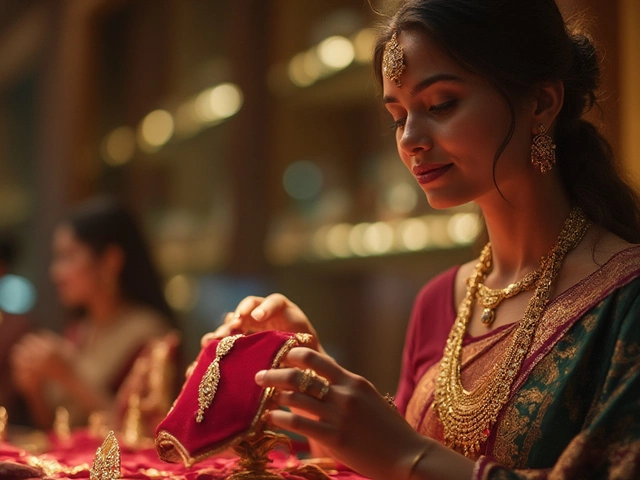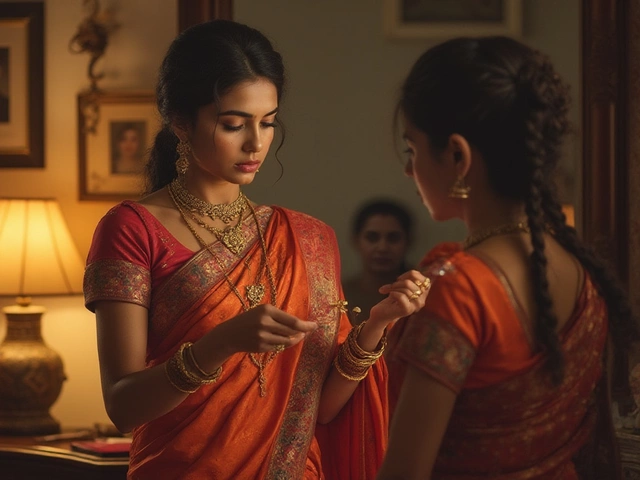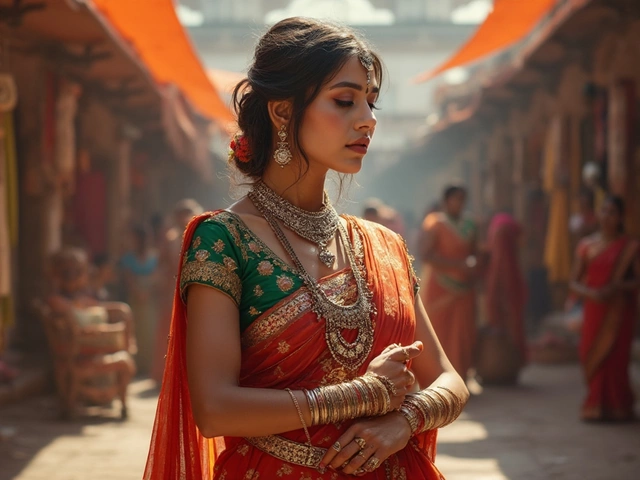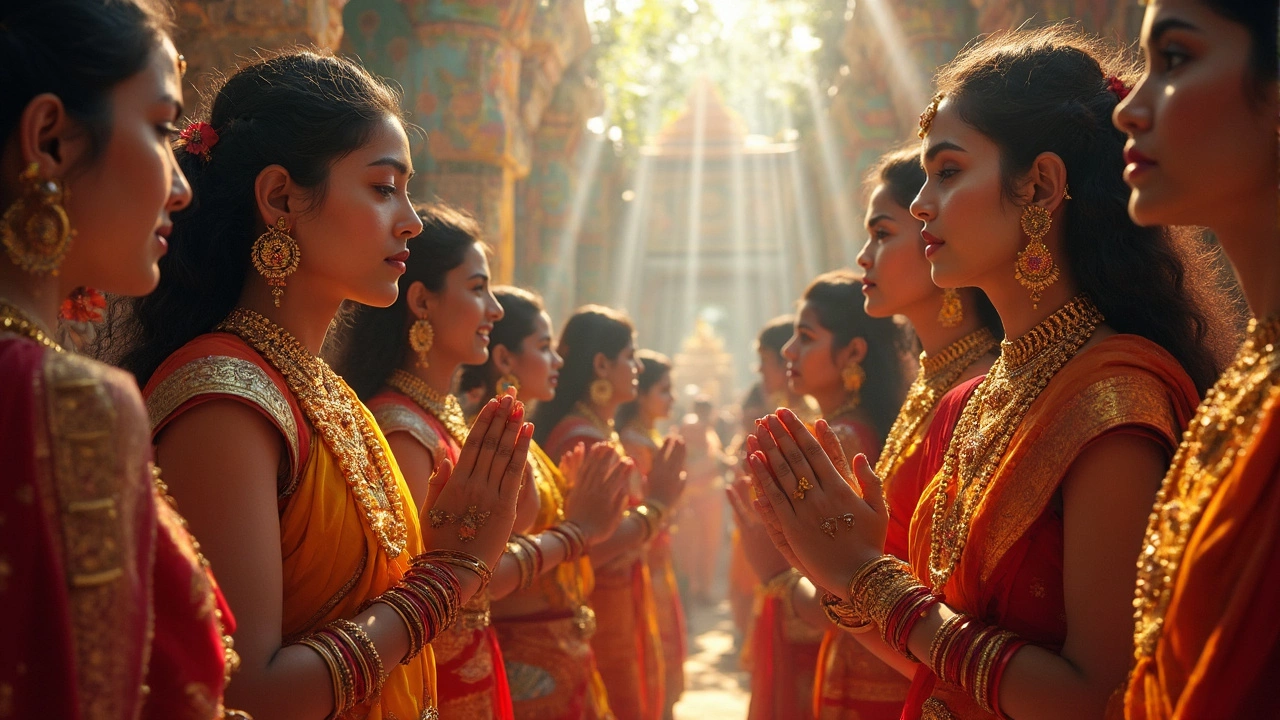
Everyone’s seen those stunning pieces of temple jewellery—heavy gold necklaces, chunky earrings, and eye-catching pendants. But Vedic jewellery isn’t just about looking fancy or showing off wealth. It all started in ancient Indian temples as a way to honor gods and goddesses during rituals. Over the centuries, these designs found their way into everyday life, mixing beauty with a ton of symbolic punch.
Here’s the cool part: Vedic jewellery isn’t made randomly. Every pattern, metal, and gemstone is chosen because someone believed it could actually make a difference—spiritually or physically. Whether it’s for bringing luck, keeping illnesses away, or boosting confidence, there’s always a reason behind each piece. Even now, people wear Vedic jewellery at weddings, festivals, or just day-to-day, holding on to traditions that go back thousands of years.
When you head out to buy temple jewellery, it’s useful to know what makes it more than just decoration. You've probably seen dancers wearing these in classical performances—each piece designed to reflect not just style, but a story or blessing. Once you start looking for the meaning behind that pendant or bangle, it suddenly feels way more personal, even if you’re not the spiritual type. And if you’re thinking about buying some yourself, knowing the basics helps you skip the cheap knockoffs and find something authentic that fits your vibe.
- Where Did Vedic Jewellery Begin and Why?
- What Sets Vedic Jewellery Apart?
- Common Motifs: Symbols With Stories
- Materials with Meaning: Why Gold, Silver, and Gems Matter
- Modern Uses and Everyday Tips
- Spotting Real Vedic Jewellery: What to Look For
Where Did Vedic Jewellery Begin and Why?
If you trace the timeline of Vedic jewellery, it goes all the way back to the Vedic period in ancient India—think more than 3,000 years ago. The Rigveda, which is one of the oldest Hindu texts, mentions people wearing gold, silver, and precious gem accessories during rituals and celebrations. Temples were the heart of community life then, so a lot of jewellery first showed up as donations or offerings to gods and goddesses.
Back then, folks believed jewellery wasn’t just about looking good. They thought certain metals and gems actually protected you from evil or brought good health. Kings, priests, and temple dancers would wear special pieces as a way of connecting with the divine, or simply for luck and status. Sometimes jewellery even worked like a family heirloom, being passed down for generations, loaded with both memories and meaning.
Temple jewellery India style got popular because it was a way to show respect towards the deities—giving the best gold and gems you had. These sacred ornaments often inspired the designs worn by classical dancers today, like Bharatanatyam and Kuchipudi artists, who still stick to traditional forms because of their cultural and spiritual weight.
Here's something a lot of people don't realize: certain gemstones and metals only went to specific gods. For example, gold was linked to the Sun god, silver to the Moon, and different colored gems had their own spiritual jobs to do. Priests followed tough rules about what could be offered, making every piece matter.
| Material | Associated Deity |
|---|---|
| Gold | Surya (Sun God) |
| Silver | Chandra (Moon God) |
| Red Coral | Mars (Mangala) |
| Pearl | Chandra (Moon God) |
The big takeaway? Vedic jewellery started as a mix of spirituality, social status, and real cultural rules. People still wear these pieces today not just for looks, but as a call back to those old traditions and beliefs that made them special in the first place.
What Sets Vedic Jewellery Apart?
The main thing about Vedic jewellery is that it’s more than just “something pretty.” This stuff has roots in India’s age-old temple traditions. You’ll spot designs that have barely changed in centuries, crafted to follow strict guidelines found in ancient texts called Agamas and Shastras. These rules tell makers what shapes, symbols, and materials are considered lucky, blessed, or even powerful.
Unlike standard fashion jewellery, every bit of temple jewellery India is packed with meaning. For example, you’ll often see the lotus (which stands for purity), peacocks (linked to prosperity), or deities worked right into the designs. There’s also a lot of attention given to symmetry—nothing's put there “just because.” Stones like rubies and emeralds get chosen for reasons that go way beyond their looks. In Vedic thinking, a ruby is tied to the Sun, boosting energy and confidence, while pearls supposedly calm the mind. People who care about astrology or spiritual health take this seriously, but even if you don’t, it’s cool to know you’re wearing a design with a backstory.
Another thing: Vedic jewellery is mostly handcrafted. You won’t find mass-produced, cookie-cutter stuff here. Each piece can take days or even weeks to make, using techniques like Jadau (setting stones without glue) or Nakashi (fine hand engraving). The idea is to respect both the craft and what the jewellery represents.
- Metals like gold and silver aren’t just chosen for glitz—they’re believed to influence energy and health.
- Large temples in India sometimes still use certain Vedic designs in rituals and processions even today.
- It’s traditional for classical dancers, like those performing Bharatanatyam or Kuchipudi, to use Vedic jewellery as part of their costumes.
| Common Gemstones | Vedic Meaning |
|---|---|
| Ruby | Strength, confidence, connection to the Sun |
| Pearl | Peace, calm, boosts the Moon's positive effects |
| Emerald | Wisdom, wealth, connected with Mercury |
| Sapphire | Protection, luck, related to Saturn |
So what sets this jewellery apart? It’s the mix of tradition, meaning, and unique handwork—plus the feeling that what you’re wearing isn't just for show, but comes with a story and purpose built right in.
Common Motifs: Symbols With Stories
When you look at Vedic jewellery, you’ll see way more than circles and loops. Each design tells a story or carries a hidden meaning from old Indian beliefs. These symbols show up again and again in temple jewellery India, and they’re not just for show—they’re thought to protect, bring luck, or keep you focused on what matters.
Let’s break down some of the most popular motifs you’ll spot:
- Lotus Flower: Seen on rings, pendants, or hairpieces. The lotus stands for purity and starting fresh, since it grows out of muddy water but looks spotless. Dancers often wear it as a symbol of beauty and spiritual growth.
- Peacock: This one is easy to spot on belts and earrings. It’s the national bird of India, symbolizing pride, beauty, and even immortality in some legends. Many believe wearing a peacock brings charm and keeps jealousy away.
- Conch Shell (Shankha): Worn in pendants or as part of bangles. In Hindu tradition, it’s a big deal for calling in positive energy and driving away the bad. It’s especially used in temple jewellery India during ceremonies.
- Goddess Lakshmi’s Feet: You’ll see tiny feet shapes, called padukas, on necklaces or belts. Lakshmi is the goddess of wealth, so anyone wanting prosperity might wear this motif.
- Elephant: Not just for statues, elephants on jewellery stand for wisdom and removing obstacles—thanks to Lord Ganesha. Earrings or pendants with this symbol are given as lucky gifts for new beginnings.
Some pieces even pack two or three of these motifs together, to double up on blessings or powers. These aren’t just things people talk about—if you visit jewelry markets in Chennai or Mumbai, vendors will tell you which symbols work best for students, business people, or brides.
Here’s a quick look at what these motifs usually stand for:
| Motif | Main Meaning | Typical Use |
|---|---|---|
| Lotus | Purity, growth | Pendants, earrings |
| Peacock | Charm, beauty | Necklaces, anklets, waist belts |
| Conch Shell | Positive energy | Rings, bangles |
| Goddess Lakshmi’s Feet | Prosperity | Long necklaces, bridal sets |
| Elephant | Luck, wisdom | Earrings, pendants |
If you’re picking out Vedic jewellery for yourself or as a gift, look for these motifs and ask about their stories. Sellers love to share the history, and you’ll have something way more meaningful than just a shiny accessory.
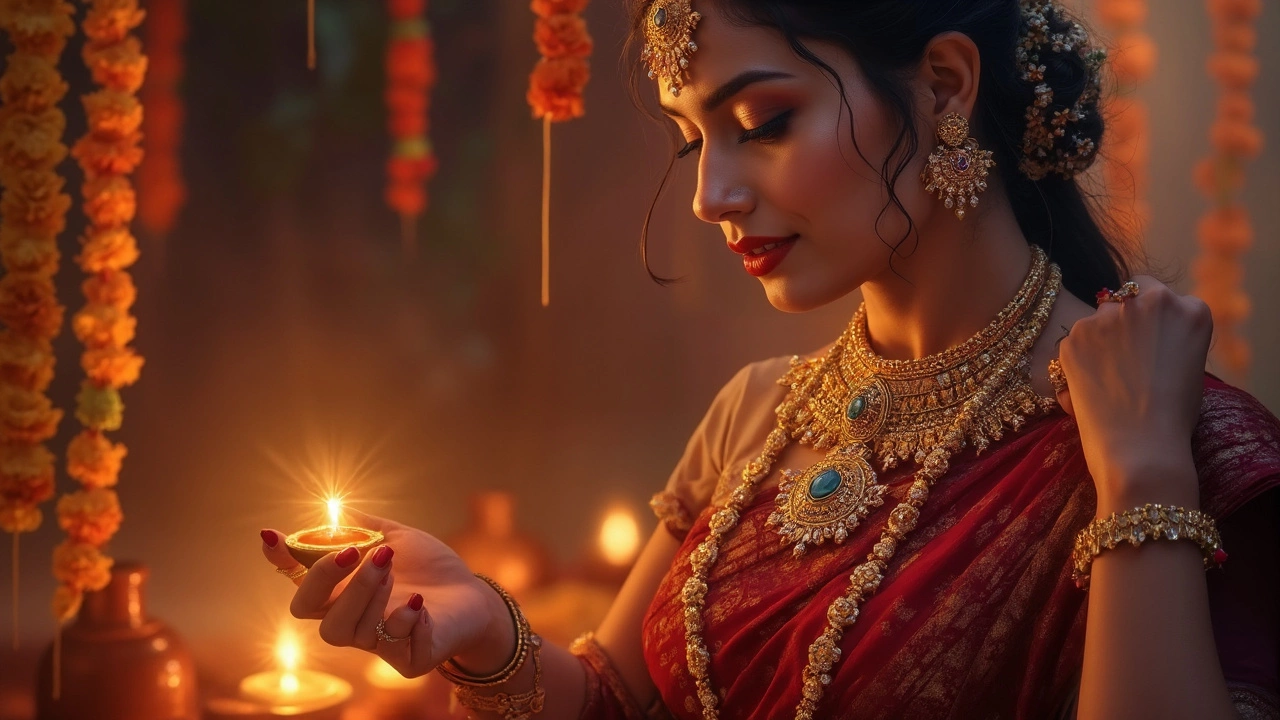
Materials with Meaning: Why Gold, Silver, and Gems Matter
It’s surprising how much thought goes into the stuff used to make Vedic jewellery. These aren’t just random picks—each metal and every gem is chosen on purpose, based on old beliefs and sometimes even modern science.
Let’s talk about gold first. In India, gold isn’t just about showing you’ve got cash. Gold is considered pure, never rusts, and has been linked to positive energy for centuries. Many families believe wearing gold brings luck and keeps negative vibes away. Back in the day, kings and priests wore gold for spiritual reasons too, not just style points.
Silver gets used a lot, especially for anklets and toe rings. People say it calms the mind, cools the body, and protects from bad luck. You’ll see silver in temple settings and festivals because it’s tied to the moon’s energy, believed to help with emotions and wellness.
Gems are where things get really personal. Every stone in temple jewellery comes with baggage (the good kind). Birthstones, for example, are picked for luck, strength, or health. Rubies represent power and love, emeralds are said to boost memory and calm the nerves, and sapphires supposedly bring wealth and focus. Some families go to astrologers to figure out which stones are right for each person.
- Gold: Symbolizes purity, prosperity, and spiritual strength
- Silver: Related to emotional balance and protection
- Rubies: Worn for energy and leadership
- Emeralds: Said to help concentration and well-being
- Pearls: Believed to calm the nerves and bring peace
And it’s not all just tradition—real-life stories back this up. You’ll see temple dancers in South India decked out in gold and gemstones, claiming the jewellery makes them feel more confident and connected—not just to the dance, but to the history behind it.
| Material | Believed Benefit |
|---|---|
| Gold | Protection, prosperity, spiritual strength |
| Silver | Calms body, emotional balance |
| Ruby | Energy, passion, leadership |
| Emerald | Wisdom, calm, memory aid |
| Pearl | Peace, emotional stability |
So, before you pick up a piece of Vedic jewellery, check what it’s made of. You’re not just buying something shiny—you’re signing up for a chunk of tradition with its own deeper meaning.
Modern Uses and Everyday Tips
Today, Vedic jewellery has moved beyond temple halls and wedding stages. People wear these pieces for all sorts of reasons, from personal style to spiritual support. A lot of folks believe that gold bracelets or gemstone rings still carry the same energy and meaning as they did centuries ago. For example, wearing a temple jewellery India pendant with a sacred symbol is thought to bring you luck or shield you from bad vibes—especially during big events like job interviews or important exams.
Fashion is another big factor now. Many jewelry designers are mixing classic Vedic designs with modern trends, making it easy to pair these items with jeans, business suits, or party outfits. Even Bollywood celebrities have been spotted rocking chunky temple necklaces or bold gemstone rings on the red carpet, sending searches for "Vedic jewellery" through the roof.
If you want to use Vedic jewellery every day, keep a few practical things in mind:
- Mix and match carefully: One bold piece, like a bangle with a Devi face or Rudraksha beads, usually stands out more than layering a bunch of heavy pieces at once. Too much and it can look overdone.
- Watch for quality: Traditional pieces use real gold or silver with natural stones. If you see ultra-cheap deals, double-check—authentic materials offer better durability and real spiritual value.
- Caring for your jewelry: Don’t wear gold or gemstone pieces in the shower or pool. Wipe off sweat and perfume after use, and store items in a soft pouch or box.
- Everyday comfort: Lightweight pendants or rings work best for daily wear. Save big, intricate sets for festivals or weddings.
- Learn about the stones: If you want more than just looks, check what different gemstones mean in Vedic tradition. For example, ruby is linked to confidence, while emerald is believed to boost memory and focus.
Want a quick look at some popular Vedic jewellery items for modern wear? Here you go:
| Jewellery Type | Common Use | Main Belief or Benefit |
|---|---|---|
| Gold nose pin | Everyday/traditional events | Represents purity and improves health |
| Navaratna ring | Daily/festive | Balances cosmic energies for protection |
| Temple pendant | Office/college | Symbolizes strength, brings luck |
| Kada (bangle) | Casual/festive | Guards against negative energy |
Bottom line: you don’t have to wait for a special occasion to wear temple jewellery India. These pieces are both a fashion choice and a meaningful connection to tradition. Just pick what fits your style (and budget), and enjoy both the look and the legacy.
Spotting Real Vedic Jewellery: What to Look For
It's easy to get fooled by regular costume jewelry dressed up to look like Vedic jewellery. Real temple pieces stand out if you know what to notice. For starters, check the craftsmanship. Handmade is a big deal here—look for tiny, detailed carvings and settings where stones are neatly fixed instead of just glued on. You’ll usually find scenes or symbols straight from Hindu mythology—think peacocks, lotus flowers, or even gods and goddesses.
Actual temple jewellery India uses solid metals like gold or silver, not anything that feels too light, bends easily, or leaves color on your skin. Authentic pieces should have a little weight to them. Bangles, necklaces, and earrings are often stamped or marked, sometimes with the purity of the metal. For gold, in India, you’ll see numbers like '22K' etched somewhere on the inside.
The stones matter too. If you see bright plastic gems, skip it. Original Vedic jewellery usually has natural gems like ruby, emerald, sapphire, or pearls. These aren't just for the looks—they're picked based on meanings tied to astrology or spiritual protection. A real piece will make you feel the cold touch of the stone if you hold it up to your cheek.
- Study the motifs: Genuine temple jewelry almost always features age-old symbols like the Om sign, swans, elephants, or conch shells.
- Ask for metal certification: Don’t be shy—good dealers show proper certificates for their gold or silver.
- Check the finish: The polish and finish should feel smooth and look even. Rough edges or chipped paint are red flags.
- Compare weight vs. size: If a big necklace feels light, it’s probably fake.
- Look for handmade details: Machine-made pieces tend to look too perfect. Real temple pieces show small marks of hand work, like slight differences in shapes or settings.
Worried about fakes? About 40% of so-called temple jewelry online is either gold-plated or made of cheaper metals. Here’s a quick comparison to help you sort things out:
| Feature | Authentic Vedic Jewellery | Imitation |
|---|---|---|
| Metal Used | Solid gold/silver (often hallmarked) | Gold-plated brass, alloy |
| Gemstones | Real rubies, emeralds, pearls, coral | Glass, plastic, synthetic stones |
| Design | Hand-carved motifs, cultural symbols | Stamped or machine-made patterns |
| Feel | Cool, weighty, smooth | Lightweight, may chip/flake |
Quick tip: If the price feels too good to be true, it probably is. Cheap deals are usually shortcuts to fakes. Take a close look, ask questions, and when in doubt, stick to trusted jewelers instead of random online shops.
